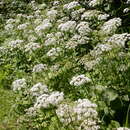ar
الأسماء في صفحات التنقل


Goutweed (Aegopodium podagraria), also known as bishop's-weed and snow-on-the-mountain, is an herbaceous perennial plant, one of several species of Aegopodium native to Europe and Asia. Most leaves are basal, with the leafstalk attached to an underground stem, or rhizome. The leaves are divided into three groups of three leaflets, making it "triternate." The leaflets are toothed and sometimes irregularly lobed. Foliage of the "wild" type is medium green in color; a commonly planted variegated form has bluish-green leaves with creamy white edges. Sometimes reversion back to solid green or a mixture of solid green and the lighter variegated pattern occurs within a patch.
Small, white, five-petaled flowers are produced in mid-summer. Flowers are arranged in flat-topped clusters (called compound umbels) and are held above the ground on a leafy stem up to about 3 feet tall. The seeds are small and elongate, similar in size and shape to carrot seeds, and ripen in late summer. In contrast to the dense foliage cover produced by goutweed, flowering shoots are uncommon in densely shaded areas.
The rhizomes of goutweed are long, white, and branching, superficially resembling those of quackgrass (Elytrigia repens, also known as Agropyron repens). Patches of goutweed typically form a dense canopy and can exclude most other herbaceous vegetation. Because of this, it is often used as a low-maintenance ground cover.
Goutweed is an aggressive invasive plant that forms dense patches, displaces native species, and greatly reduces species diversity in the ground layer. Goutweed patches inhibit the establishment of conifers and other native tree species as well. An ecologically versatile species, Goutweed is found in old gardens and flowerbeds, around shrubs and other plantings, and in a variety of other disturbed habitats such as felled forests, abandoned fields, and pastures. In Eurasia, goutweed is primarily a species of deciduous and southern boreal forests, and it expands aggressively in similar habitats in North America. Goutweed appears to do best on moist soil and in light to moderate shade, but is highly shade-tolerant and capable of invading closed-canopy forests.
Goutweed is currently known to occur in twenty-nine states in the mid-Atlantic, Northeast and Northwest (USDA PLANTS map) and is reported to be invasive in natural areas in Connecticut, Michigan, New Jersey, Pennsylvania, Vermont, and Wisconsin (WeedUS Database).